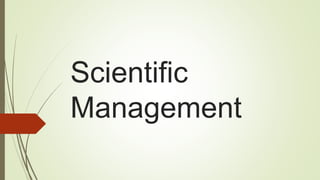
Scientific Management.pdf
- 2. Introduction This theory was developed by F. W. Taylor. He was primarily concerned about the efficiency of workers and optimum utilization of resources. His principles and techniques were based on the observations he conducted in the factory. Scientific management can be defined as application of science for each and every element of management.
- 3. Scientific Principles of Management 1. Principle of Science, not rule of thumb: According to this principle, Taylor insists that each job performed in the organization should be based on scientific inquiry and not on intuition and experience. Rule of thumb means dictatorship of manager whereas scientific decisions are based on cause and effect and scientific measurement of methods and ways of production. 2. Principle of Scientific selection & Training of workers:The procedure for selection of workers should be designed scientifically. The selected workers should be trained to avoid wrong methods of work. It must provide opportunities for the development of workers having better capabilities.
- 4. 3. Principle of Cooperation:Scientific management is based on cooperation between management and workers, as also between workers themselves. Scientific management also promotes cooperation among workers and departments. 4. Principle of maximum output:Both the management and workers should try to achieve maximum output in place of restricted output. Maximum output will result in higher wages for the workers and greater profit for the management. 5. Principle of equal division of work:There must be equal division of responsibility between the managers and the workers. The management should assume responsibility for the work for which it is better suited.
- 5. Techniques of Scientific Management 1. Functional Foremanship: The division of factory in 2 departments: planning department and production department as Taylor felt that workers must be free from the burden of panning and they must concentrate on work and production. To develop specialization in the productivity, Taylor suggested under each department there must be some functional experts to supervise, guide and instruct the worker. 2. Standardization and Simplification of work: Scientific management always emphasizes on maintaining standards relating to every step of business operation. Standardization does not mean only quality standards but it refers to setting up standards for size, type, weights, measures and quality of product. Simplification emphasizes on elimination of unnecessary diversity of product, size and types.
- 6. 3. Work Study: It ensures maximum production at minimum cost and getting best contribution from every factor. It includes: A. Fatigue study: I. The frequency of rest intervals. II. The duration of rest intervals. III. The no. of rest intervals. B. Method Study: This technique is conducted to find out the one best method or way of performing the job which keeps production cost minimum and makes maximum use of resources of the organisation.
- 7. C. Time Study: Taylor suggested to observe an average worker for this study. I. The standard time required to perform a job. II. Setting up the standard target for workers. III. Determining the no. of workers required to perform a job. IV. Categorizing the workers in efficient and inefficient categories. D. Motion Study: I. To determine the movements of workers when they are performing the job. II. To differentiate between productive and unproductive movements. III. For cutting down unproductive and wasteful movements. IV. To design suitable equipment and tools to minimize the unproductive movements of workers.
- 8. 4. Differential piece wage system: a) Paying different rate of wage to efficient and ineffecient workers. b) Extra wages paid to efficient employees will motivate them to remain efficient. c) Extra wages paid to efficient employees will motivate inefficient employees to come in the category of efficient employees. d) When payment is given according to no. of units produced automatically the production will be maximized .
- 9. 5) Mental Revolution: a) Change in mental attitudes of workers and management towards each other. b) Co-operation between workers and management. c) Ruling out feeling of suspicion or prejudice from the minds of workers and management to adapt systematic thinking.
- 10. Conclusion Taylor’s scientific techniques were effective to some extent but it also exploits the human resources .Human resources are considered as machines.